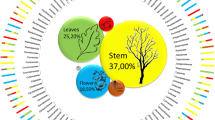Abstract
An ethnobotanical survey of practicing dyers in the biodiversity rich ecosystems of Sierra Leone and of the literature was conducted on the common plant species used to produce natural dyes. In addition, the methods used to obtain these dyes and to dye fabric, together with the techniques used to produce various patterns on fabric were investigated. Although the thriving dye industry is now predominantly serviced by synthetic dyes, the knowledge of the plants used still survives among some dyers, who use plant dyes to some extent. However this indigenous knowledge is rapidly being lost as increasingly less of it is being passed on to succeeding generations. Several plants used in the dyeing process are documented, together with their taxonomic characteristics; local names; how the dyes are produced and fabric dyed; the colors obtained; in addition to how various patterns are designed. Sustainable utilization of this important renewable natural resource is discussed.
Résumé
Cette étude ethnobotanique porte sur les teinturiers exerçant en Sierra Leone, pays doté d’écosystèmes riches en biodiversité, et recense les espèces végétales souvent utilisées dans la production de teintures naturelles, ainsi que les publications y afférentes. De plus, elle examine les méthodes d’extraction des teintures, de coloration des tissus et de création des divers motifs. Bien que cette industrie florissante utilise principalement des teintures synthétiques, certains teinturiers connaissent encore les plantes servant à produire des teintures naturelles. Mais ce savoir disparaît rapidement, car il est de moins en moins transmis aux générations futures. L’étude présente plusieures plantes utilisées dans la fabrication des teintures, ainsi que leurs caractéristiques taxinomiques, leurs noms locaux, les méthodes de production des teintures et de teinture des tissus, les couleurs obtenues, et la conception des motifs. Elle envisage enfin l’exploitation durable de cette importante ressource renouvelable.
Similar content being viewed by others
Literature cited
Abbiw, D. 1990. Useful plants of Ghana. Intermediate Technology Publications Ltd., U.K.
Adrosko, R. J. 1968. Natural dyes in the United States. Smithsonian Institution Press, Washington D.C., U.S.A.
Balfour-Paul, J. 2002. Indigo—past and present. Proceedings of the color congress 2002: The art, history, and use of natural dyes.
Bellemare, M. 1993. Local color in a traditional plant-extracting dye from red sorghum. IDRC Report. Vol. 21, No. 3.
Bliss, A. 1981. A handbook of dyes from natural materials. Charles Scribner’s Sons, N.Y.
Bollag, J.-M. 1998. A chemist reintroduces Turkish carpet makers to the secrets of natural dyes. Chronicle of Higher Education. Vol. 44, Mo. 35, May 8, B2.
Burkill, H. M. 1985. The useful plants of West Tropical Africa. Royal Botanic Gardens, Kew, U.K.
Cole M., and D. Hamilton. 1978 Indigenous technology in Sierra Leone. Ministry of Social Welfare, Sierra Leone.
Cole N. H. A., and C. A. MacFoy. 1992. Underexploited tropical economic plants in West Africa. Journal of the Faculty of Pure and Applied Science (Fourah Bay College, University of Sierra Leone) 1(1):40–56.
CIDA. 2001. CIDA update.
Crystals Youth Club. 1985. Manual on the art of gara dyeing in Sierra Leone. Crystals Youth Club Secretariat.
Diallo, A. D. 1997. Return of traditional dyes in Guinea. IDRC Report. Vol. 23, No. 1.
Dalziel, J. M. 1937. Useful plants of West Tropical Africa. Crown Agents, London.
Deighton, F. C. 1957. Vernacular botanical vocabulary for Sierra Leone. Crown Agents, London.
Dudley, J. P., et al. 2001. Effects of war and civil strife on wildlife and wildlife habitats. Conservation Biology 16(2):319–329.
Fyle, C. 1962. A history of Sierra Leone. Oxford University Press, U.K.
Gilbert, K. 1997. Cultivation and extraction of natural dyes for industrial use. http:www.iacr.bbsrc.ac.uk/ lars/depts/plantsci/tdyeplant.html
Green, C. L. 1995. Natural colorants and dyestuffs. Non-wood forests products, UNFAO, Rome.
Hill, D., et al. 2000. Cultivation and extraction of natural dyes for industrial use in natural textiles production. http://www.nf-2000.org/secure/Air/S223. htm
Institute for Environmental Studies (IES). 1995. Case studies of community-based forestry enterprises in the Americas. Symposium. Forestry in the Americas: Community-based management and sustainability. University of Wisconsin-Madison.
Lebbie, A. R., and R. P. Curries. 1995. Ethnobotanical value and conservation of sacred groves of the Kpaa Mende in Sierra Leone. Economic Botany 49(3):297–308.
MacFoy, C. A. 1992. Biologically active natural products of plant origin. In P. Kapoor-Vijay and James White, etd., Conservation biology. Commonwealth Science Council.
MacFoy, C. A., and A. M. Sama. 1983. Medicinal plants in Pujehun District of Sierra Leone. Journal of Ethnopharmacology 8:215–22.
McCarthy, B. J. 1999. Biotechnology and coloration—emerging themes and practical applications. Journal of the Society of Dyers and Colourists 115: 54–55.
Polakoff, C. 1982. African textiles and dyeing techniques. Routledge and Kegan Paul Ltd., U.K.
Redferm, C. 2001. Dyeing naturally and sustainably in the south west, US. SW Studies. 499http:// anthro. fortlewis. edu/ ethnobotany/ Dbase/ images/ Documents/SW-DYEPLANTS-2.htm
Savill, P. P., and J. E. D. Fox. 1967. Trees of Sierra Leone. Government of Sierra and United Kingdom.
Walker, G. 1997. Microfinance in Sierra M Leone. In UNDP Microfinance Assessment. Report, http:// www. fenu. borg/sum/reports/assessments/country. reports/sierradb.html
Weigle, P. 1974. Ancient dyes for modern weavers. Watson-Guptill Publications, New York.
Wilson, E. O. 1988. Biodiversity. National Academy Press. Washington, D.C.
Wright, E. H., and S. B. Cole. 1988. Studies on the chemical and physicochemical nature of «gara» dyeing. Chemistry in Sierra Leone 7:43–59.
Author information
Authors and Affiliations
Rights and permissions
About this article
Cite this article
Macfoy, C. Ethonobotany and sustainable utilization of natural dye plants in Sierra Leone. Econ Bot 58 (Suppl 1), S66–S76 (2004). https://doi.org/10.1663/0013-0001(2004)58[S66:EASUON]2.0.CO;2
Received:
Accepted:
Issue Date:
DOI: https://doi.org/10.1663/0013-0001(2004)58[S66:EASUON]2.0.CO;2




